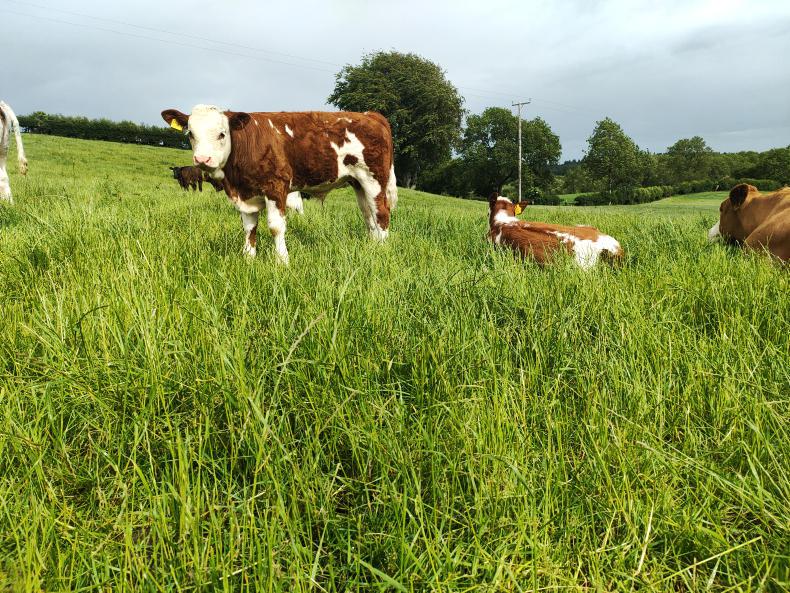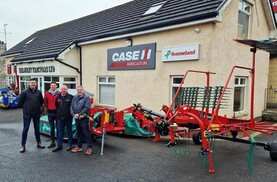When the weather was dry, grassland management was very simple on this farm. Growth was slow, but it was always just above demand and I was able to cut some surplus grass for bales.
I got through May without any serious loss in quality and utilisation was excellent. Cattle were content and I probably had a bit of a smug grin, as I thought that my grassland management was just about perfect.
I would have been very happy without any rain. We kept sowing fertiliser and we felt that we were getting a good response.
Well, as always happens here in Fermanagh, the rain arrived, and plenty of it. I am sick of it already. With the wet weather has come a burst of growth and I have essentially lost control of grass in just one week.
It hasn’t been just the burst of growth – everything has gone to seed head in the blink of an eye.
Blame
I have lots of things that I can blame it on, whether it is the surge in growth, the weather or the fact that I have been really busy with a new batch of calves coming in.
But the truth is that I have taken my eye off the ball and it’s my own fault. I think I got a little ahead of myself and thought that I was in full control, when really it was the weather keeping everything in check, rather than my grass management skills.
Having been brought down to earth with a bump, it’s now time to do something about this.
I will continue to sow fertiliser whenever the opportunity is there
There are probably plenty of farmers who would be of the opinion that you just stop sowing fertiliser, and keep grazing out the swards until you have the grass back under control.
In my opinion, this is a foolish thing to do. By the time you have it under control, you are actually heading for a deficit, as re-growths are poor. Add to this the fact that you have absolutely no quality in the grass you are grazing now, and therefore no performance in the livestock.
I will continue to sow fertiliser whenever the opportunity is there. And as soon as I can see a prospect of two dry days in a row, I intend to cut some paddocks for bales.
I have lots of paddocks that are suitable for cutting, but I can’t cut everything in the one go, as you then end up with no grass and everything coming back into the grazing rotation at the one time.
What I will try and do is to cut some paddocks each week, in an effort to stagger the regrowth.
Split
But there are some paddocks that have gotten too strong, which I am going to have to graze. What I try and do is to split them in half, so that the cattle do not spend too long grazing out each paddock. Then, I top them with a mower to clean off the stemmy grass that is left.
In the past, I have also done things like pre-mowing
An alternative is to bring in dry autumn-calving cows to clean out paddocks. It’s not always that simple, but I try and do it where possible.
In the past, I have also done things like pre-mowing. This involves coming in and mowing the grass ahead of the cattle, and this helps them clean out the paddocks. In my experience, it’s very hard to get this right. It works best in dry weather and you need to be mowing and moving every day, which is not always practical on a suckler farm.
I have my work cut out over the next few weeks
All in all, there are lots of options for me and in reality, it will be a combination of all of these that will bring the grass back under control.
I have my work cut out over the next few weeks, but here’s hoping for a long dry summer to make best use of the grass.
Read more
Watch: teasers take the strain of heat detection
Farmer Writes: hopefully the sun keeps shining
When the weather was dry, grassland management was very simple on this farm. Growth was slow, but it was always just above demand and I was able to cut some surplus grass for bales.
I got through May without any serious loss in quality and utilisation was excellent. Cattle were content and I probably had a bit of a smug grin, as I thought that my grassland management was just about perfect.
I would have been very happy without any rain. We kept sowing fertiliser and we felt that we were getting a good response.
Well, as always happens here in Fermanagh, the rain arrived, and plenty of it. I am sick of it already. With the wet weather has come a burst of growth and I have essentially lost control of grass in just one week.
It hasn’t been just the burst of growth – everything has gone to seed head in the blink of an eye.
Blame
I have lots of things that I can blame it on, whether it is the surge in growth, the weather or the fact that I have been really busy with a new batch of calves coming in.
But the truth is that I have taken my eye off the ball and it’s my own fault. I think I got a little ahead of myself and thought that I was in full control, when really it was the weather keeping everything in check, rather than my grass management skills.
Having been brought down to earth with a bump, it’s now time to do something about this.
I will continue to sow fertiliser whenever the opportunity is there
There are probably plenty of farmers who would be of the opinion that you just stop sowing fertiliser, and keep grazing out the swards until you have the grass back under control.
In my opinion, this is a foolish thing to do. By the time you have it under control, you are actually heading for a deficit, as re-growths are poor. Add to this the fact that you have absolutely no quality in the grass you are grazing now, and therefore no performance in the livestock.
I will continue to sow fertiliser whenever the opportunity is there. And as soon as I can see a prospect of two dry days in a row, I intend to cut some paddocks for bales.
I have lots of paddocks that are suitable for cutting, but I can’t cut everything in the one go, as you then end up with no grass and everything coming back into the grazing rotation at the one time.
What I will try and do is to cut some paddocks each week, in an effort to stagger the regrowth.
Split
But there are some paddocks that have gotten too strong, which I am going to have to graze. What I try and do is to split them in half, so that the cattle do not spend too long grazing out each paddock. Then, I top them with a mower to clean off the stemmy grass that is left.
In the past, I have also done things like pre-mowing
An alternative is to bring in dry autumn-calving cows to clean out paddocks. It’s not always that simple, but I try and do it where possible.
In the past, I have also done things like pre-mowing. This involves coming in and mowing the grass ahead of the cattle, and this helps them clean out the paddocks. In my experience, it’s very hard to get this right. It works best in dry weather and you need to be mowing and moving every day, which is not always practical on a suckler farm.
I have my work cut out over the next few weeks
All in all, there are lots of options for me and in reality, it will be a combination of all of these that will bring the grass back under control.
I have my work cut out over the next few weeks, but here’s hoping for a long dry summer to make best use of the grass.
Read more
Watch: teasers take the strain of heat detection
Farmer Writes: hopefully the sun keeps shining






 This is a subscriber-only article
This is a subscriber-only article









SHARING OPTIONS: